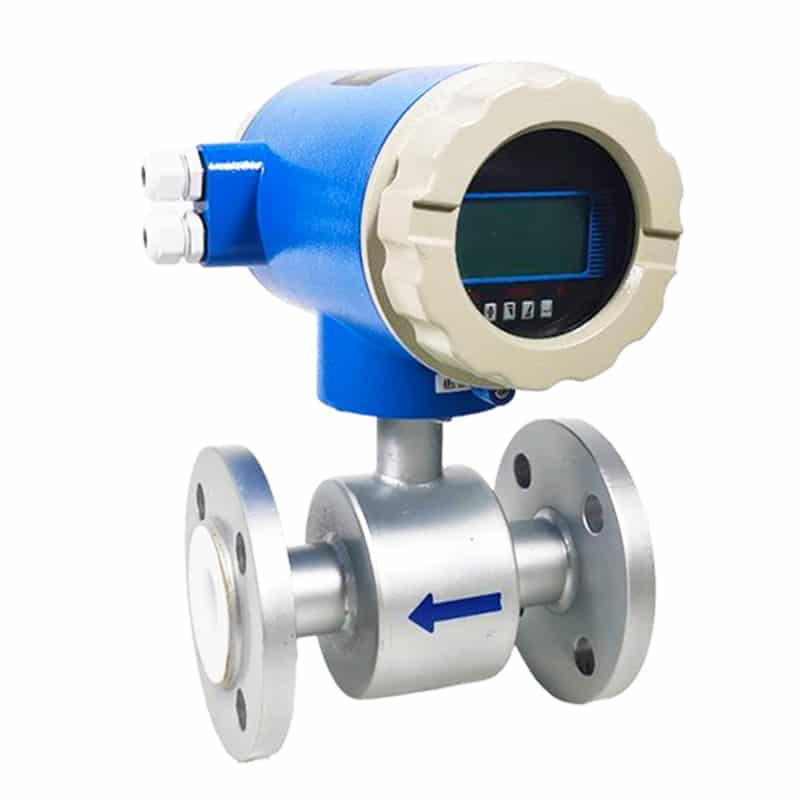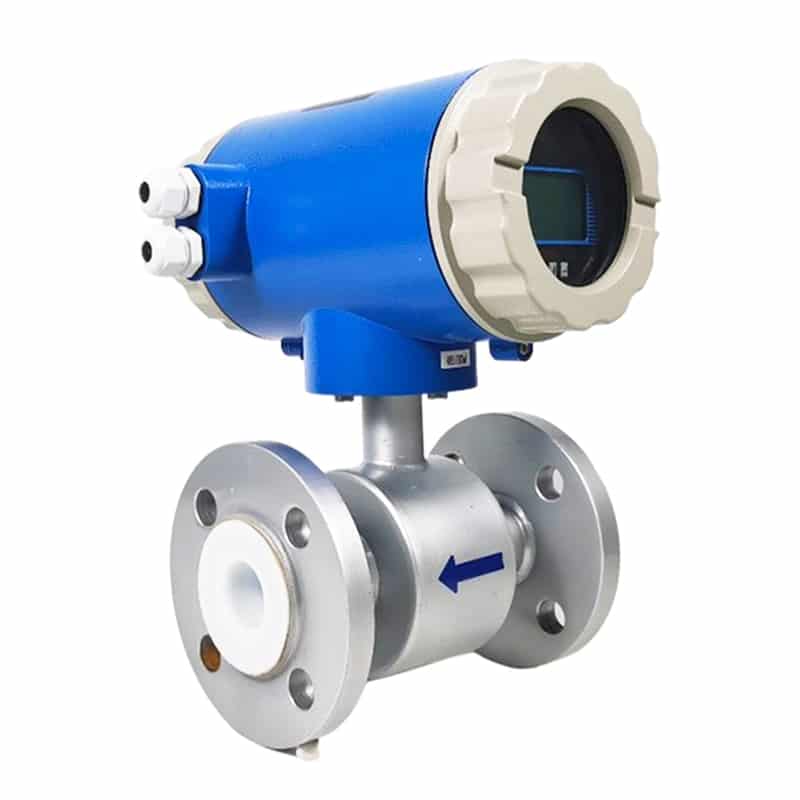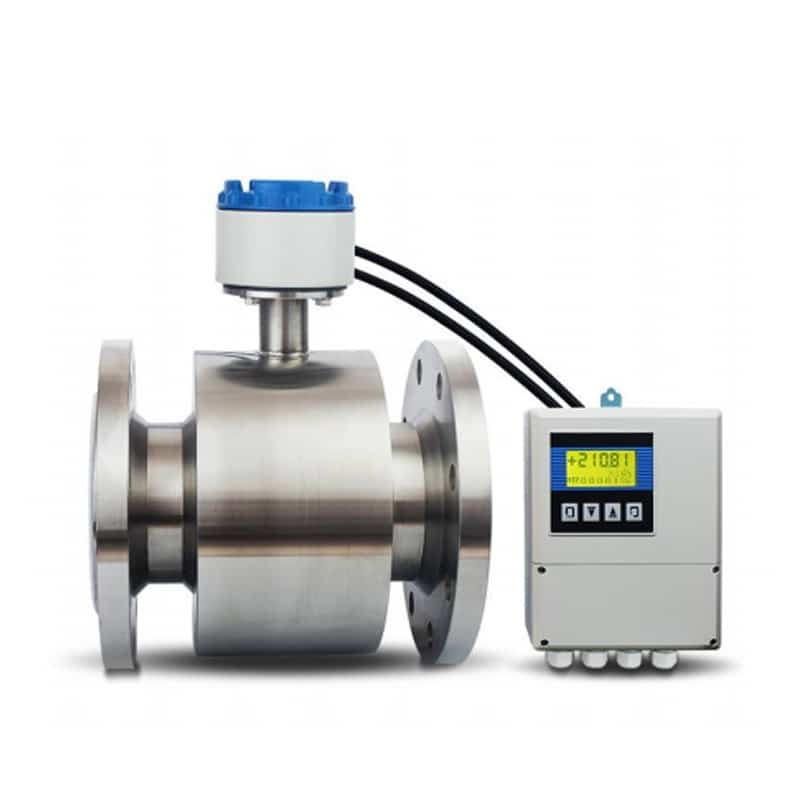Magnetic flow meter is a key instrument for measuring flow in fluid flow. Its accuracy, wide range of applications, stability and easy maintenance make it an indispensable and important tool in various industrial and commercial applications, providing reliable data support for flow control and monitoring.
Magnetic flow meter working principle introduction
Magnetic flow meters utilize Faraday’s Law of Electromagnetic Induction to determine the flow rate of a fluid by measuring the changes in voltage and current in an electrically conductive liquid (e.g., water) surging through the fluid. When an electrically conductive liquid passes through a magnetic field, the charge carriers (usually ions) in the liquid create a potential difference that results in an electric current. By measuring the voltage and current in the fluid, the flow rate of the fluid can be determined.
Apure AYT digital liquid magnetic flow meter with fast response and elimination of output noise, its design and quality control system to ensure the high accuracy and reliability of the product, the application of lining makes the magnetic flow meter more widely used.


Preparation of magnetic flow meters before calibration
Before performing a magnetic flow meter calibration, you first need to ensure that the following preparations are made to ensure that the flow meter is in proper working condition:
- Check the condition of the equipment: Check the appearance of the magnetic flow meter for damage or foreign objects, make sure the surface of the equipment is clean, and check that the cables and connecting wiring are intact.
- Clean the fluid line: Make sure the fluid line is clean and free of impurities or deposits to avoid any impact on the flow meter measurement.
- Pre-calibration calibration: Perform a pre-calibration to check the basic function and measurement accuracy of the flow meter so that potential problems can be detected in time.
- Preparation of calibration equipment: prepare the required calibration equipment and tools, including standard flow meter, calibration liquid, calibration power supply.
- Calibration environment preparation: Ensure that the calibration environment meets the requirements, including the stability of temperature, humidity and pressure, etc., in order to ensure the accuracy and repeatability of the calibration process.
Calibration method for magnetic flow meters
Standard meter method
This method calibrates the flow meter to be calibrated by comparing it to a standard meter of known accuracy and precision. The standard meter can be another calibrated flow meter or a standard flow meter with a known flow rate. The accuracy and error value of the flow meter to be calibrated is determined by connecting the flow meter to be calibrated and the standard meter at the same time to the same fluid line and making comparative measurements under certain flow conditions.
Static mass method
This method is based on the law of conservation of mass, using the principle of constant mass flow rate calibration. By installing weighing instruments or mass flow instruments at the inlet and outlet of the flow meter to be calibrated, the mass change before and after the fluid passes through the flow meter is measured, so as to calculate the accurate mass flow rate of the flow meter to be calibrated. This method is suitable for application scenarios that require high precision and accuracy, but also requires sophisticated equipment and operating techniques to ensure accuracy.
Calibration of split magnetic and insertion flow meters
Split magnetic flow meters
Calibration is usually performed using the standard comparison method. This method requires the magnetic flow meter and the standard flow meter or calibration device connected together, by adjusting the parameters of the split magnetic flow meter to make its output consistent with the standard.

Insertion type magnetic flow meter
The calibration method can be used according to the specific circumstances of the quantitative injection method or static method. In the quantitative injection method, can be inserted into the magnetic flow meter by injecting a known flow rate and volume of liquid, and then compared with the flow rate measured by the magnetic flow meter to determine its accuracy and calibration. In the static method, calibration can be performed using the static state of the liquid, where the mass or volume of the liquid is measured by a calibrated instrument and compared to the measurements of the insertion type magnetic flow meter.

Calibration process details
Calibration of a magnetic flow meter typically involves the following specific steps and processes:
- Setting calibration points: Determine the required calibration points, usually selecting a few key points covering the flow range. According to the actual needs and application scenarios, choose calibration points with different flow values for calibration.
- Prepare calibration equipment: Prepare calibration equipment and tools such as standard flow meter, calibration liquid, calibration power supply, etc. and connect them to the magnetic flow meter.
- Start calibration: Connect the magnetic flow meter to the calibration equipment and start the calibration process. According to the set calibration points, adjust the calibration parameters of the magnetic flow meter one by one, such as zero calibration, full scale calibration, etc., to ensure the measurement accuracy of the magnetic flow meter under different flow rates.
- Adjust the calibration parameters: According to the calibration results and the measured values of the standard flow meter, adjust the calibration parameters of the magnetic flow meter step by step, including zero offset, sensitivity, linearity, etc., until the ideal calibration effect is achieved.
- Verify the calibration results: After completing the calibration, the magnetic flow meter is verified, comparing the calibrated measurement results with the measured values of the standard flow meter to ensure the accuracy and reliability of the calibration.
When performing magnetic flow meter calibration, the following key details and tips need to be noted:
- Ensure that the calibration environment is stable to avoid external disturbances affecting the calibration results.
- Care should be taken during calibration to record the adjustment parameters and measurement results at each calibration point for subsequent analysis and verification.
- Pay attention to the selection and use of calibration fluids to ensure that they are similar to the measured medium and meet the calibration requirements.
- During the calibration process, follow the equipment operation manual and calibration procedures, and strictly follow the standard operation steps to ensure the validity and traceability of the calibration.
Post-calibration verification and adjustment:
The post-calibration verification step is an important part of ensuring the accuracy and stability of magnetic flow meter measurements. The process typically consists of the following steps:
- Comparison of calibration results with standard values: The calibrated magnetic flow meter measurements are compared with those of a standard flow meter or other reliable standard. For each calibration point, the measured value of the magnetic flow meter and the standard value are recorded and the deviation or error between them is calculated.
- Error analysis: Compare the deviation between the calibration results and the standard values and perform an error analysis. Based on the magnitude and direction of the error, assess the accuracy and stability of the calibration and determine whether further adjustment of the calibration parameters is required.
- Adjustment of calibration parameters: Based on the results of the error analysis, adjust the calibration parameters of the magnetic flow meter if necessary. Parameters such as zero offset, sensitivity, linearity, etc. can be adjusted to make the calibrated measurement results closer to the standard values and improve the accuracy and reliability of the measurement.
- Re-verification: The adjusted magnetic flow meter is verified again, and the calibration results are repeatedly compared with the standard values to ensure the validity and stability of the calibration parameter adjustments. According to the results of the re-verification to determine whether the calibration meets the requirements, whether further adjustment or optimization is required.
Calibration of magnetic flow meters can be problematic
Sources of error: The calibration process may be disturbed by external factors, such as electromagnetic interference, temperature changes, pressure fluctuations, etc. These factors may lead to measurement errors and affect the accuracy of the calibration results.
Inaccurate calibration equipment: If the standard equipment or standard fluid used is inaccurate or failed, it will affect the reliability of the calibration results. Therefore, it is critical to check and maintain calibration equipment on a regular basis.
Unstable flow conditions: Unstable flow conditions during calibration may lead to fluctuations in measurement results and affect calibration accuracy. Therefore, it is critical to ensure stable flow conditions during calibration.
Incorrect calibration parameters: If the calibration parameters are set incorrectly, such as zero offset, sensitivity, linearity and other parameters are set incorrectly, it will lead to inconsistency between the calibration results and the actual measurement values, affecting the accuracy of the measurement.
Human operation error: improper operation or operation error of the operator may also lead to problems in the calibration process, such as improper selection of calibration points, improper adjustment of parameters, etc.
Equipment aging or damage: long-term use or improper use may lead to aging or damage to the magnetic flow meter equipment, thus affecting its measurement performance and calibration results.
Summary
Calibrating magnetic flow meters is critical to ensure the accuracy and reliability of flow measurements, improving the stability and safety of industrial processes. Calibration reduces equipment losses, extends equipment life and meets regulatory requirements, thus providing companies with reliable data support and contributing to increased productivity and reduced costs.
Apure offers magnetic flow meters as well as vortex flow meters, turbine flow meters, ultrasonic flow meters and float flow meters. Feel free to consult us if you have any questions.
